This is the first of a five-part series on Mormon speculative fiction.
The question of what Mormon literature is becomes complicated when we’re talking about science fiction and fantasy. How can a book about spaceships and aliens (or magic and elves) be said to be Mormon literature? Speculative fiction–the genre that encompasses science fiction, fantasy, horror, and other related sub-genres–is inherently about things that are unreal. Can such a genre meaningfully engage with the culture and theology of a real people in the here and now? I would argue that there are three different ways that speculative fiction participates in the Mormon conversation. In this post, we’ll address the first and most obviously Mormon of these three genres of writing speculative fiction, with the other two genres to come in future posts.
I’ll call this first genre “religious speculative fiction” because this is the category in which a writer uses speculative fiction to directly engage with Mormon theology and doctrine. This type of writing straddles the boundary between historical fiction, speculative fiction, and religious devotional writing. The writer starts from the doctrines of the church received through scripture, contemporary revelation, or cultural belief and then expands them into a fully realized world. This process inherently involves inventing details not present in sources: details of the pre-Earth life and our capabilities there, details of the plans and actions of Heavenly Father and Satan, details on the culture of Book of Mormon civilizations. Most authors, no doubt, employ the best research they can to find genuine details on these topics, but in the end, speculation is definitely involved to create a fully fledged work.
The Earliest Mormon Speculative Fiction
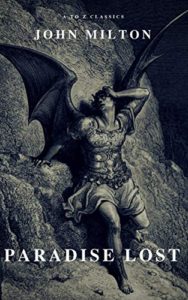 This type of speculative fiction is the earliest one in the history of Mormon literature. I would assume this genre came to be largely because of the popularity of this type of story at the time of the founding of the church. John Milton’s epic Paradise Lost was very popular during the time period and was hugely influential on religious thought at the time. John Rogers, a professor of English at Yale, recently gave a lecture at the Maxwell Institute and an interview on the Maxwell Institute podcast on the connections between Paradise Lost and early Mormon theology. His book on the subject is still forthcoming, but I think the attention early Mormons paid to Milton’s fictional account of the fall are not coincidental to their own attempts to find truth by writing speculative religious works.
This type of speculative fiction is the earliest one in the history of Mormon literature. I would assume this genre came to be largely because of the popularity of this type of story at the time of the founding of the church. John Milton’s epic Paradise Lost was very popular during the time period and was hugely influential on religious thought at the time. John Rogers, a professor of English at Yale, recently gave a lecture at the Maxwell Institute and an interview on the Maxwell Institute podcast on the connections between Paradise Lost and early Mormon theology. His book on the subject is still forthcoming, but I think the attention early Mormons paid to Milton’s fictional account of the fall are not coincidental to their own attempts to find truth by writing speculative religious works.
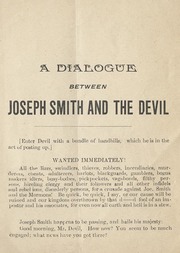 I know of two 19th century works of Mormon literature fit this category–they might be then called the first works of Mormon speculative fiction. They might not generally be recognized as science fiction, but contain elements of the genre nonetheless. The first is a short story or play by Parley P. Pratt in 1844 entitled “A Dialogue between Joseph Smith and the Devil,” which portrays a conversation between the two regarding the success of the Restoration. This story has been often cited as the first piece of Mormon fiction, but its place in speculative fiction
I know of two 19th century works of Mormon literature fit this category–they might be then called the first works of Mormon speculative fiction. They might not generally be recognized as science fiction, but contain elements of the genre nonetheless. The first is a short story or play by Parley P. Pratt in 1844 entitled “A Dialogue between Joseph Smith and the Devil,” which portrays a conversation between the two regarding the success of the Restoration. This story has been often cited as the first piece of Mormon fiction, but its place in speculative fiction 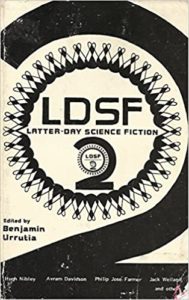 has gone largely unnoticed by scholars. However, the Mormon science fiction movement has several times claimed the piece as its own, even including it in an anthology of LDS science fiction stories (LDSF-2: Latter-Day Science Fiction 2 edited by Benjamin Urrutia in 1985).
has gone largely unnoticed by scholars. However, the Mormon science fiction movement has several times claimed the piece as its own, even including it in an anthology of LDS science fiction stories (LDSF-2: Latter-Day Science Fiction 2 edited by Benjamin Urrutia in 1985).
As a work of science fiction, the piece is fairly shallow. The speculative fiction elements are completely in service of the religious allegory. The story exists to convey a didactic attempt to preach the truth of the Mormon message. However, it undeniably represents an attempt to represent the tenets of the LDS religion through a speculative fiction framework.
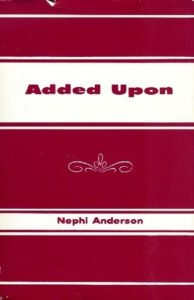 Another early Mormon work claimed by the science fiction movement is Nephi Anderson’s Added Upon, written in 1898. A well known early Mormon novel, Added Upon is claimed as science fiction on the basis of its speculation on the nature of the pre- and post-mortal life of its protagonists. This book inaugurated Mormon speculative fiction as a way to explore the details left dark by doctrine. In this way, Added Upon can be seen as the forefather of the uniquely LDS speculative fiction tradition of spirit fiction stories. These stories have continued to be popular and include the cultural touchstone of Saturday’s Warrior as well as other book series such as Chris Stewart’s The Great and The Terrible.
Another early Mormon work claimed by the science fiction movement is Nephi Anderson’s Added Upon, written in 1898. A well known early Mormon novel, Added Upon is claimed as science fiction on the basis of its speculation on the nature of the pre- and post-mortal life of its protagonists. This book inaugurated Mormon speculative fiction as a way to explore the details left dark by doctrine. In this way, Added Upon can be seen as the forefather of the uniquely LDS speculative fiction tradition of spirit fiction stories. These stories have continued to be popular and include the cultural touchstone of Saturday’s Warrior as well as other book series such as Chris Stewart’s The Great and The Terrible.
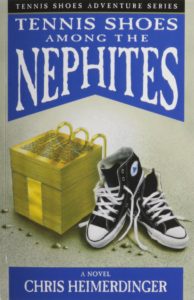 I’d be remiss as a child of the 1990s if I didn’t also include the Tennis Shoes Among the Nephites series in this category, though in a slightly different category since it doesn’t focus on the pre-mortal life. Like the currently popular Outlander books and TV series, the time travel mechanisms in Tennis Shoes start out as merely a plot device to enable the writer to place modern characters in a time period they want to discuss. But as the series waxes on, the time travel becomes more complicated. The characters save scriptural texts from evil wizards, interfere in history, and generally have all the hallmarks of a complex time travel saga. Obviously, all of this is still in service of the overall goal of interesting tweens in the Book of Mormon, but it’s clearly religious speculative fiction.
I’d be remiss as a child of the 1990s if I didn’t also include the Tennis Shoes Among the Nephites series in this category, though in a slightly different category since it doesn’t focus on the pre-mortal life. Like the currently popular Outlander books and TV series, the time travel mechanisms in Tennis Shoes start out as merely a plot device to enable the writer to place modern characters in a time period they want to discuss. But as the series waxes on, the time travel becomes more complicated. The characters save scriptural texts from evil wizards, interfere in history, and generally have all the hallmarks of a complex time travel saga. Obviously, all of this is still in service of the overall goal of interesting tweens in the Book of Mormon, but it’s clearly religious speculative fiction.
Is This Really Science Fiction?
I recognize that Saturday’s Warrior may not be what most people picture when they talk about Mormons writing science fiction, or even fantasy. I mean, how have I gone through a whole blog post on Mormon speculative fiction and not mentioned Scott Card or Brandon Sanderson? And most scholars certainly wouldn’t talk about Paradise Lost as a forefather of fantasy. Yet, I feel this is an important connection to make.
These religious novels go beyond a typical religious allegory to be more speculative about their subject. Allegories like Everyman and Pilgrim’s Progress abounded in medieval Christianity. Yet Paradise Lost is something distinct from these plays. Rather than representing characters who are cardboard cut-outs of well-known virtues or retelling well-known Biblical stories, Milton adds to the existing material, telling a realistic story about fantastical events. He gives Lucifer especially a depth of feeling and motivation that rivals any character in a novel. Things that are merely symbols become real, detailed, and solid. Essentially, Milton has given us a fantasy novel, where before we had only fairy tales.
These early Mormon speculative religious fiction works accomplish a similar thing for Mormon doctrines about the spirit life. As President Oaks has recently reminded us, “What do we really know about conditions in the spirit world? I believe a BYU religion professor’s article on this subject had it right: “When we ask ourselves what we know about the spirit world from the standard works, the answer is ‘not as much as we often think.’”” These works take a few scattered references and turn them into a living breathing world.
I would argue that what these books have done is world-building, one of the cornerstones that sets speculative fiction apart from historical fiction or general fiction. It is, admittedly, essentially different from modern science fiction and fantasy authors who create worlds out of whole cloth. But I would argue that it is equally far away from the historical fiction writer who scrupulously researches every detail in order to get an accurate portrayal. This option is not available to religious speculative fiction writers, who must stick to a few key facts, but otherwise have a lot of freedom in designing what they think the spirit world (or Book of Mormon times) might be like.
Whether you buy my argument or not, I hope you’ll stick around for my next few posts where I’ll introduce the two other type of Mormon speculative fiction. But first we’ll digress into a story about how the current flood of Mormon speculative fiction writers came to be.
(Next week: The Foundations of Mormon Speculative Fiction: Orson Scott Card and the Class that Wouldn’t Die)
 Liz Busby is a writer of creative non-fiction and speculative fiction. She loves reading science fiction, fantasy, history, science writing, and self help, as well as pretty much anything that holds still for long enough. Liz graduated from BYU with a BA in English, and lives in Bellevue, WA, with her husband and four kids. Follow her writing at www.lizbusby.com.
Liz Busby is a writer of creative non-fiction and speculative fiction. She loves reading science fiction, fantasy, history, science writing, and self help, as well as pretty much anything that holds still for long enough. Liz graduated from BYU with a BA in English, and lives in Bellevue, WA, with her husband and four kids. Follow her writing at www.lizbusby.com.

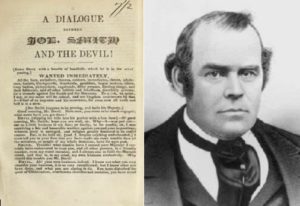
So glad you’re writing these.
Pratt also has a story called 100 Years Hence which is utopian speculation. Could fit into this frame as world building about the Millennium.
Liz (if I may), just curious: would you consider Parley P. Pratt’s “The Angel of the Prairies; or a Dream of the Future” to be speculative fiction?
It seems to me the behold-my-dream-of-the-future trope was used by other writers of utopias in the past to speculate about what a perfect society might look like.
I had not heard of this Pratt Utopia story! I will have to look into it. It does seem along the same lines of religious spec fic. Utopia stories are definitely an ancestor of modern sci fi, particularly the dystopia genre that’s was so popular in YA in the 2000s.
You should probably add to your list Nephi Anderson’s Beyond Arsareth (1921)
I hope you will be including Pam Blackwell’s Millenial Series Her first novel, Ephraim’s Seed, was published in 1995. It was the first of a projected four-novel series, The Millennial Series—a fictionalized account of happenings in the time just before and then during The Millennium. The following two novels in the series were Jacob’s Cauldron (1998) and Michael’s Fire (2002). The concluding novel in the series will be entitled David’s Throne.
I’ve just realized I’ve made a terrible ommission by not including the Book of Laman and the Book of Abish by Mette Harrison. Sticking them here in the comments for posterity.
.
I’m excited to see what else you’ll be bringing in this series!
As a note, in commemoration of 175 years of Joe Smith and the Devil, Irreantum will be having a themed issue. Announcement coming soon!
.
Oh. And if we’re just helping you expand your list, three I’m still talking about are The Invisible Saint, Monsters & Mormons, and Brother Brigham.
Hmmm. Are Book of Mormon retellings like Book of Laman and Book of Abish included in your list?
I kind of think they are their own genre? Along with Corianton and A Ship of Hagoth and a bunch of other similar stories (although Harrison’s works aren’t quite the same as the rest of the genre, I admit).
Kent, you bring up an interesting point about slanted or expanded retellings of scripture. Some are more fable/fairy tale like, but some definitely have the world building aspect that I argue makes them religious speculative fiction. It would be interesting to do more research on this genre.
And, I just came across one more possible speculative fiction story: Nephi Anderson’s 2nd short story, Grandmother’s Rocking Chair. Depending on how you see the requirements, it is a time-travel story akin to A Connecticut Yankee…
.
Whaaaaaat!
Here’s a link to Nephi Anderson’s Grandmother’s Rocking Chair:
https://www.amazon.com/Grandmothers-Rocking-Chair-Nephi-Anderson-ebook/dp/B08HJHQG5T/